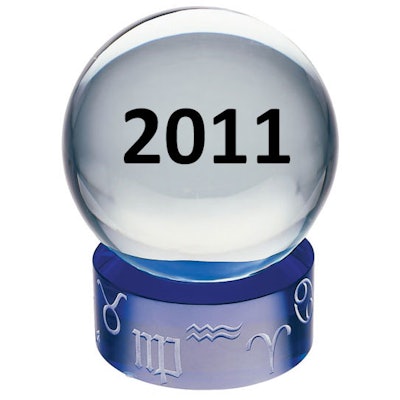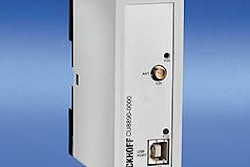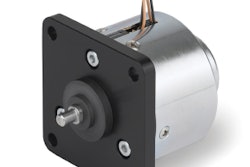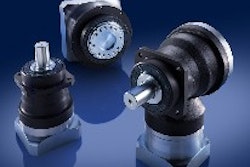I spoke with Craig van den Avont, the president of GAM Gear in Mt. Prospect, IL. Craig’s business sells and distributes gearboxes and couplings, and he also does custom manufacturing of those products, so he is both an automation supplier and user. I asked Craig for his thoughts about 2011, but I started with his biggest surprise in 2010. Craig’s response: “we anticipated some growth in 2010, but not this much. Business really increased in the second half of 2010. We saw that many companies held off from investing in equipment and were holding on to cash, fearful of a double-dip recession. When that did not materialize there was a large pent up demand to invest in new technology and replace aging equipment. The net result was a surge of purchasing in the latter half of the year.
So, what is in store for 2011? “We will see spending continue, but not at the same pace” says Craig. “At this time inventories are also being replenished throughout the supply chain, after that occurs we will see some cooling off. However, business will continue to be good for the Automation Market because manufacturers will continue to invest in equipment for two reasons, the cost of automation has come down and some manufacturing is moving back to America. The cost of automation has gone down, which increases the affordability even to small businesses. We are a good example of that. We are considering implementing new equipment with automation to increase productivity.
“Another factor to the increase in domestic automation purchases is the realization that low-cost manufacturing in Asia is not a panacea for everyone. Soft costs, like transportation, quality issues, communication, and the requirement for cash-in-advance elevate the low initial costs that we see from the “low-cost” suppliers. With these additional costs, local manufacturing with automation starts to make more sense.”
“For the new economy, companies need to be flexible when responding to customer demands. You have to be Lean, but you also need good collaboration between the supplier and customer. Customers are not willing to take the risk involved with placing large blanket orders with releases spaced over a long period. Instead, they want to place orders only for what they need, want quick delivery and expect the best price. As a supplier that is possible if we collaborate with the OEM to understand their needs and forecasts. For example, if you get an order of a few hundred pieces, it is almost certain that not every piece is required right away. We work with our customers whenever possible to space out the delivery of this order to match our production capacity. That way, we can produce to the customer’s true needs, while being cost-effective. If you have planning and collaboration on both sides of the table, it is a win-win.”
John Donahue, manager for USA SV product support at Krones Inc. has a similar view. “For 2011 in packaging, I see companies ordering new equipment as well as opening up to projects that were put on hold. End user companies will have a lot more involvement in the process and be focused more on the cost. This will increase competition and bring back small businesses. Machine manufacturers will continue to make gains over last year. A new focus of energy saving processes added to current machines or new machine design will gain momentum this year as well.”
John also has a perspective on machine control systems: “I had thought machine manufacturers would become standardized on a single controller system throughout the machines. While machine manufacturers have made many machine groups based on a standard design and functional display/controls, I thought a single manufacturer design would be possible. However, we still use the strengths of several companies’ designs throughout our machines. I am talking about, for example, using Allen Bradley Controls alongside B&R Controls alongside Siemens Controls. It is quite remarkable how the companies have made it possible to integrate each other’s equipment side by side even though they are competitors.”
Joe McClain is the Vice President for Specialty Components (Berg/Highfield/Stearns) at Rexnord. One of his divisions recently completed a $1.3M installation of machining equipment. Joe has a history in training and selling automation solutions, but now he is responsible for all aspects of product manufacture, sales and marketing. Here’s what Joe has to say about his recent project, and how new automation can benefit traditional manufactured components.
“For the past three years, we have been phasing out 30-40 year old machines. We have been combining processes, and with a recent installation, we have taken out seven machines and replaced them with one. There was a lot of manual load/unload on the old line, but now we go from bar stock to a completed part all in one operation. We picked this operation because it would take about 30% of the production time out of this operation. In addition, we can scale up based on the type of gear, and the customer demand, as this is fully automatic. Our goal is to add 3 more over the next 18 months, if this one works out well”, says Joe.
What are some of the ways to make a new automation project successful? “When we are purchasing new machining line, the planning process is critical, specifically in allocating time to planning the floor/utilities to receive the machine”, Joe says. “First of all, we need to determine the priority of the products to be manufactured. We wrote the programs months in advance for the critical parts, for example.”
“We integrate the pricing model into the new manufacturing process as well, offering reduced pricing based on this new process about 8 weeks before the machines are ready. This allows us to be competitive even before the parts came off the new line.”
“Another success factor is forming a team including maintenance and materials management, as well as the operators and programmers. We involve people that normally are not normally part of the planning process, and this leads to a smoother startup for us.
Joe Biondo has worked in marking and sales for Bosch Rexroth and Festo. He is currently an independent automation consultant and can be reached at [email protected].



























